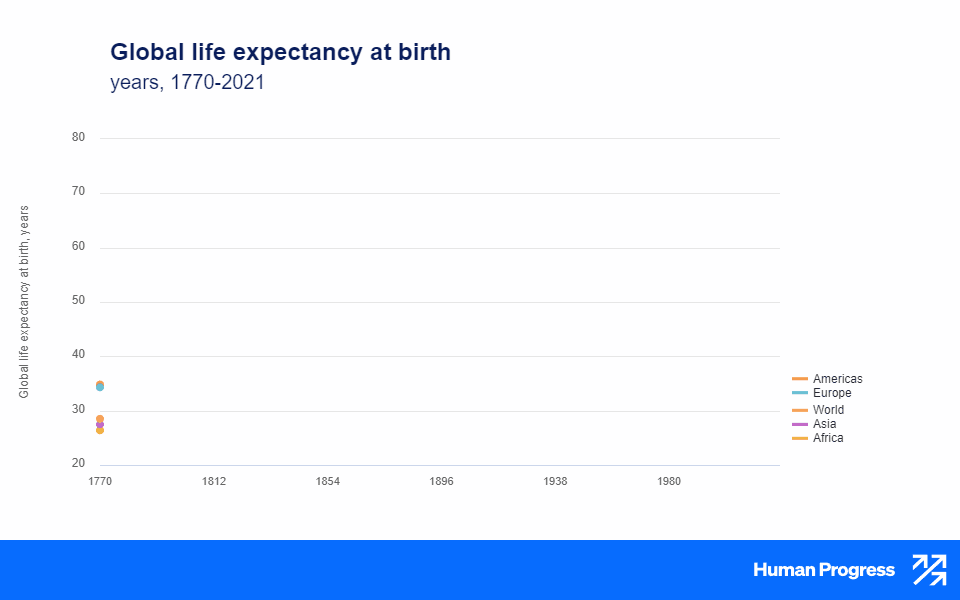Today marks the thirty-eighth installment in a series of articles by HumanProgress.org called Centers of Progress. Where does progress happen? The story of civilization is in many ways the story of the city. It is the city that has helped to create and define the modern world. This bi-weekly column will give a short overview of urban centers that were the sites of pivotal advances in culture, economics, politics, technology, etc.
Our thirty-eighth Center of Progress is Cambridge during the Scientific Revolution. The 16th and 17th centuries constituted a period of drastic change in the way humanity conceptualized and sought to understand the world. Scholars made massive leaps in fields such as mathematics, astronomy, chemistry, and, perhaps most notably, physics. Arguably, no city contributed more profoundly to that new understanding than Cambridge.
Today, Cambridge is a picturesque and walkable university city filled with stunning architecture, cozy pubs, and brilliant minds. “Cambridge is heaven … As you walk round, most people look incredibly bright, as if they are probably off to win a Nobel Prize,” says author Sophie Hannah. Indeed, if Cambridge were a country, it would rank fourth on the list of countries according to its number of Nobel Prize winners. Cambridge is nicknamed the “city of perspiring dreams” as a nod to its scholars’ tireless dedication, in contrast to rival university city Oxford’s older nickname, “the city of dreaming spires.”
The great minds that have defined Cambridge are reflected in its architecture and artworks. Architectural highlights include the Gothic-style King’s College chapel, featuring the world’s largest fan vault, and the Mathematical Bridge, designed in 1749 with the technique of tangential radial trussing, which creates the illusion of an arch although the bridge is built only of straight timbers. The conduit gutters, or runnels, lining many of the city’s ancient streets and university buildings owe their construction to none other than Thomas Hobson, the successful stable-owner-turned-benefactor from whom we get the term Hobson’s choice (e.g., “take it or leave it”). The city also boasts fascinating artworks such as the Corpus Chronophage Clock, a massive “inside-out” electromechanical timepiece that lets onlookers view the usually hidden grasshopper escapement mechanism. The clock is topped with a moving statue called the Chronophage (“time eater”), a grasshopper-like entity constructed from stainless steel, gold, and enamel. According to the artist, the horologist and Cambridge alumnus John Taylor (b. 1936), “the time is exactly correct every fifth minute to one hundredth of a second.”
Cambridge is also known for the Fitzwilliam Museum, the city’s lively market square, and the pastime popular among tourists and students alike of punting (a method of boating in shallow water) on the River Cam—the natural feature around which the city was built. The waterway has made the area an attractive farmsteading site since the Iron Age, and has allowed Cambridge to serve as a trading center throughout the ages, including for the Romans (who called the city Duroliponte, meaning “the fort at the bridge”), the Vikings, and the Saxons.
But the true significance of Cambridge began with the founding of Cambridge University, which started with a murder mystery. In 1209, a woman was found killed in Oxford, and her death caused an uproar that would alter the course of academic history. She was a local and her fellow townspeople blamed outsiders drawn to their city to study and teach at Oxford University. At the time, most of the university’s students were teenage clerics, also called clerks. The primary suspect was a liberal arts clerk, who promptly fled his rented home.
The townspeople resented the clerks’ special legal privileges, relative wealth, and reputation for drinking and fighting—tense town versus gown relations are nothing new. The killing took on an urgent significance in the broader conflict between the townspeople and the university, and a mob of riotous locals soon imprisoned the suspect’s roommates. This occurred in the midst of a power struggle between the Church and the crown. The excommunicated King John is said to have personally ordered the hanging of the imprisoned clerks “in contempt of the rights of the church.” The other pupils and instructors at the university fled, fearing further executions. To this day, the crime has not been solved—some say the killing was an accident, while others claim it was murder.
The dispersed scholars, possibly including the alleged killer, continued their studies elsewhere. What would become Cambridge University started as “no more than a bunch of scholars who had fled from Oxford and who had started to teach their students in rented houses in the neighborhood around St. Mary’s Church.” St. Mary’s Church today marks the center of Cambridge. In 1214, when the king and the Church had reconciled, Oxford’s townsfolk were made to welcome back scholars and offer them reduced rents. But tensions remained high in Oxford (boiling over periodically, such as in the St. Scholastica’s Day riot), and many ex-Oxonians chose to remain in Cambridge.
Soon Cambridge University was an intellectual powerhouse in its own right, where great thinkers took human understanding of the world to new heights. “I find Cambridge an asylum, in every sense of the word,” the English poet A. E. Housman once quipped. And indeed the city birthed ideas so groundbreaking that many of them may have sounded mad when they were first expressed.
Cambridge has nurtured great minds in many areas of achievement. Consider the arts. Cambridge’s streets have been trod throughout the centuries by literary and poetic geniuses, including Edmund Spenser (1552–1599), Christopher Marlowe (1564–1593), John Milton (1608–1674), William Wordsworth (1770–1850), Lord Byron (1788–1824), Alfred Tennyson (1809–1892), William Thackeray (1811–1863), A. A. Milne (1882–1956), C. S. Lewis (1898–1963), Vladimir Nabokov (1899–1977), Sylvia Plath (1932–1963), and Douglas Adams (1952–2001). Famous Cambridge alumni include comedians, such as John Cleese (b. 1939), Eric Idle (b. 1943), Sacha Baron Cohen (b. 1971), and John Oliver (b. 1977), as well as award-winning actors such as Emma Thompson (b. 1959) and Hugh Laurie (b. 1959). And Cambridge gave the world musical feats ranging from the comedic Always Look on the Bright Side of Life to the well-known 1980s hit Walking on Sunshine.
Next consider philosophy and economics. Cambridge educated the celebrated Catholic theologian, humanist philosopher, and pioneer of religious tolerance Erasmus (1466–1536). Other noted philosophers who were Cantabrigians include Bertrand Russell (1872–1970) and Ludwig Wittgenstein (1889–1951). Cambridge was also the alma mater of influential economists, such as the overpopulation alarmist Thomas Malthus (1766–1834), the father of the beleaguered field of macroeconomics John Maynard Keynes (1883–1946), and Nobel Prize winners Milton Friedman (1912–2006) and Angus Deaton (b. 1945).
But Cambridge’s greatest contributions to human progress arguably came in the natural and physical sciences. William Harvey (1578–1657), the physician and anatomist who first detailed the human blood circulatory system, studied at Cambridge. Francis Bacon (1561–1626), the father of empiricism and one of the founders of the scientific method, studied at Cambridge and represented Cambridge University (which for a time was a Parliament constituency with its own representatives) in the British Parliament in 1614.
Most historians consider the Scientific Revolution to have begun with the insight of the Polish astronomer Nicolaus Copernicus (who studied in Bologna, another Center of Progress, and in Padua) that the Earth orbits the sun rather than the sun orbiting the Earth. However, the revolution culminated in the quiet university city of Cambridge with the writing of Newton’s Philosophiæ Naturalis Principia Mathematica (the Principia, published in 1687), a groundbreaking work that advanced mankind’s knowledge of physics and cosmology. To this day, Cambridge University Library retains the first edition print of the book owned by author Isaac Newton (1642–1727), which contains his handwritten notes for the second edition scrawled across it.
If Newton was the father of modern physics, then Cambridge was arguably the field’s birthplace. The course of Newton’s life revolved around Cambridge; one might say the city’s intellectual gravity kept him in its orbit and he could not resist its pull. He received both his bachelor’s and master’s degree from Cambridge University. Like Bacon, Newton briefly served as member of Parliament for the University of Cambridge (from 1689–1690 and 1701–1702). In 1669, only a year after completing his master’s degree, Newton became the Lucasian Chair of Mathematics, which is now among the most prestigious professorships in the world, and remained in that position until 1702.
The professorship was made possible thanks to private funding from a benefactor named Henry Lucas (c. 1610–1663). He was a clergyman, politician, and Cambridge alumnus who also generously bequeathed a collection of some four thousand books to the University Library at Cambridge. Other famous Lucasian professors include the mathematician Charles Babbage (1791–1871), often called the “father of computing” for conceiving the first automatic digital computer; and the theoretical physicist Stephen Hawking (1942–2018), who, despite severe health challenges from amyotrophic lateral sclerosis (ALS is a progressive motor-neuron illness), made several notable contributions to his field, including conceptualizing Hawking radiation. The Lucasian Chair has even attracted the attention of popular culture: in the well-known science-fiction franchise Star Trek, a central character named Data is said to hold the Lucasian Chair in the late 24th century.
The privately funded professorship allowed Newton to make several breakthroughs in the fields of mathematics, optics, and physics, such as developing the first reflecting telescope. Generous private funding also made publication of the Principia possible. The astronomer and physicist Edmond Halley (1656–1742), the namesake of Halley’s Comet and the heir to a soap mogul, traveled to Cambridge to encourage, edit, and fund the publication of Newton’s Principia. In his book, Newton demonstrated how the planets orbit the sun, controlled by gravity. A popular legend holds that Newton first formulated the theory of gravity in the mid-1660s after watching an apple fall from a tree. The precise apple tree often said to have inspired him is, remarkably, still alive—it stands around 70 miles northwest of Cambridge in Newton’s family home, Woolsthorpe Manor. Grafted from that storied tree, another “Newton’s apple tree” can now be viewed in Cambridge. Whether Newton ultimately did his most momentous thinking in his birthplace or in his intellectual home at Cambridge, one thing is certain: the Principia took the world by storm. Its publication is often said to have laid the foundation of modern physics.
After the Scientific Revolution, Cambridge continued to produce world-changing thinkers, such as Henry Cavendish (1731–1810), the discoverer of hydrogen (which he termed “inflammable air”). Later, Cambridge’s Cavendish Laboratory was home to major discoveries, including that of the electron in 1897, the neutron in 1932, and the structure of DNA in 1953. The latter came about thanks to the work of physicist Francis Crick (1916–2004) and biologist James Watson (b. 1928), who may have built on findings by other Cantabrigians, including chemist Rosalind Franklin (1920–1958). The physicist Niels Bohr (1885–1962), who developed the Bohr model of the atom, also studied at Cambridge. The university city was the site of other groundbreaking moments in scientific history, too, such as the invention of in vitro fertilization technology (1968-78), the first identification of stem cells (1981), and the earliest eye-recognition technology (1991).
It also must be mentioned that Cambridge educated the founder of evolutionary biology, Charles Darwin (1809–1882). He forever altered understanding of living things by positing the fundamental scientific concepts of animal and human evolution and natural selection. Along with Newton, he is probably the most influential figure in scientific history to emerge from Cambridge’s classrooms—and one of the most influential men in history, period.

Cambridge grew from its unconventional murder-mystery origins into an intellectual center that played a pivotal role in the Scientific Revolution, which is often said to have been made complete with the publication of the Principia. Thanks to the rigorous culture of Cambridge’s academic community and funding from generous benefactors, the city has often served as the headquarters of mankind’s quest for truth and understanding. Many scholars believe that the new way of thinking that emerged during the Scientific Revolution directly led to the Enlightenment movement in the 17th and 18th centuries. The innovations of the Scientific Revolution continue to form the basis for humanity’s present understanding of the natural world, including modern physics. It is for these reasons that we must gravitate toward Cambridge as our 38th Center of Progress.






